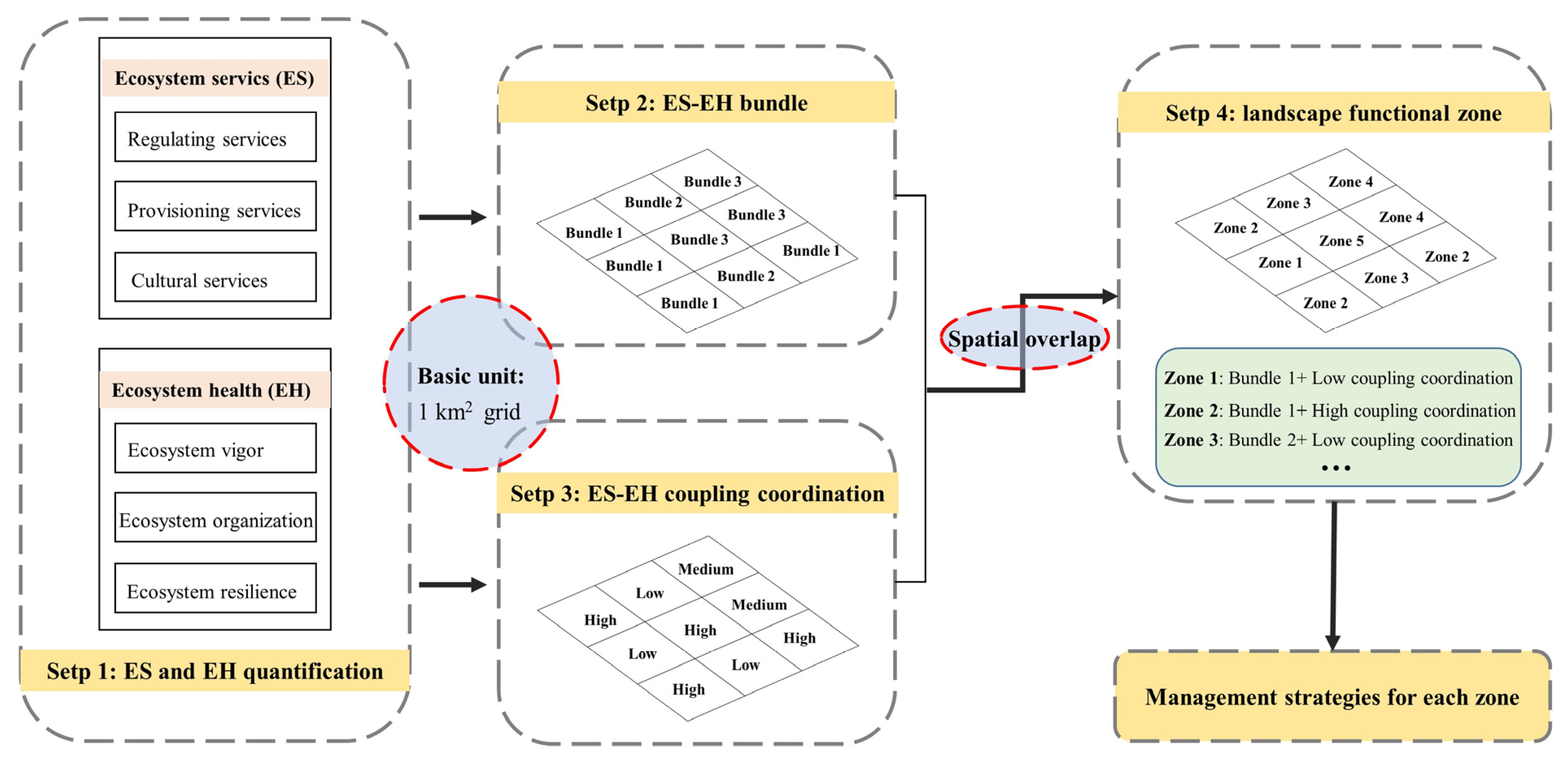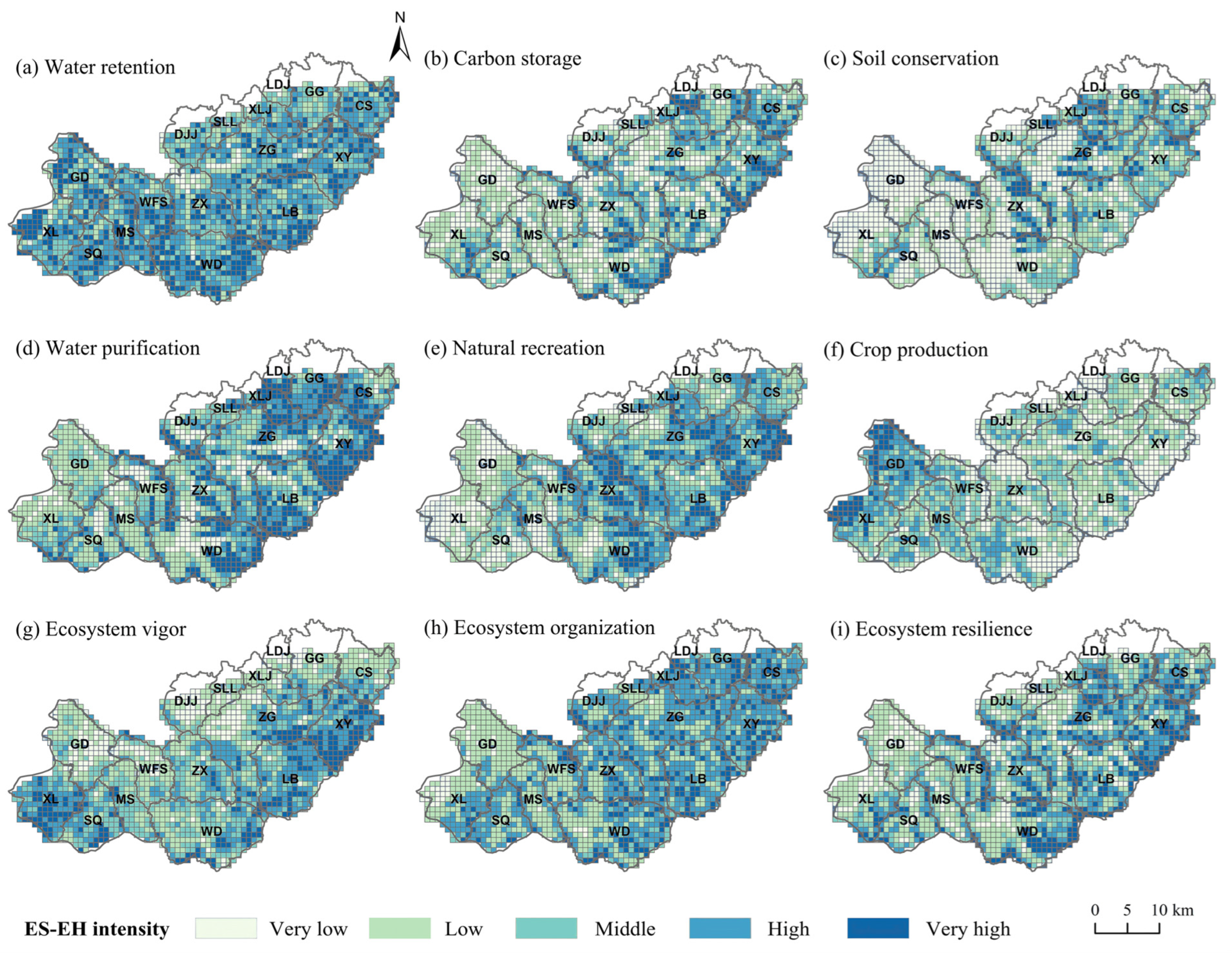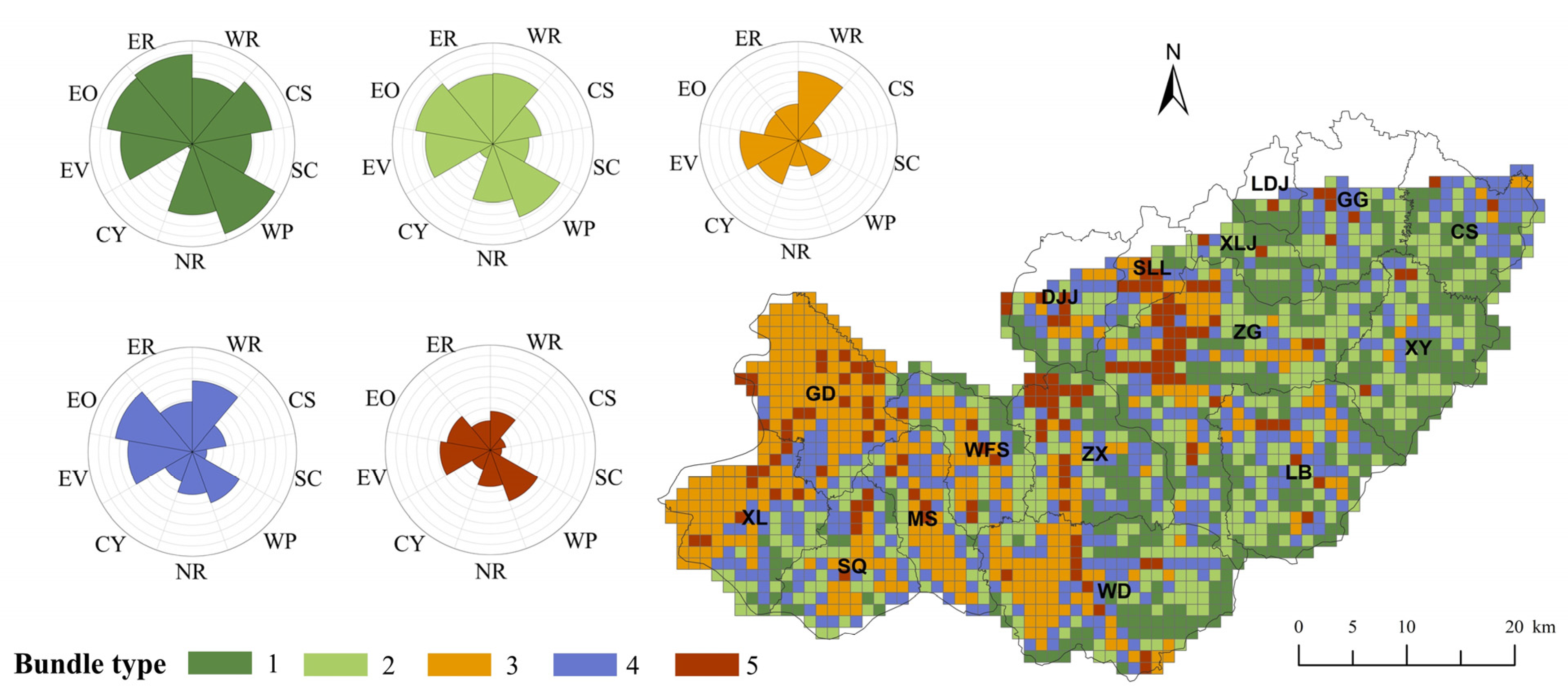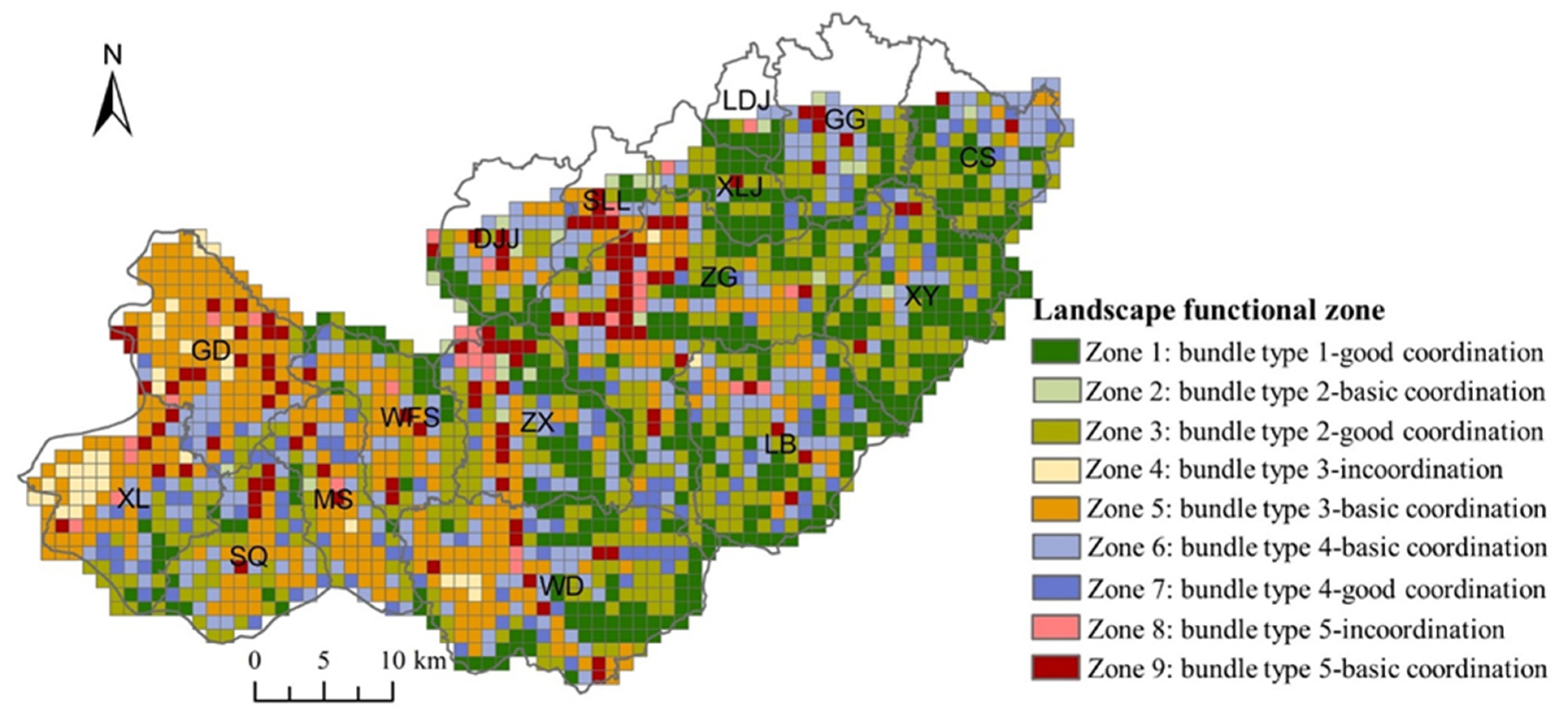Integrating Ecosystem Services and Health into Landscape Functional Zoning: A Case Study of the Jinan Southern Mountainous Area, China
Abstract
:1. Introduction
2. Study Area
3. Methodology
3.1. Research Design
3.2. Data Source
3.3. ES Selection and Quantification
3.3.1. Water Retention
3.3.2. Carbon Storage
3.3.3. Soil Conservation
3.3.4. Water Purification
3.3.5. Natural Aesthetics and Recreation
3.3.6. Crop Production
3.4. EH Quantification
3.4.1. Ecosystem Vigor
3.4.2. Ecosystem Organization
3.4.3. Ecosystem Resilience
3.5. Coupling Coordination Analysis
3.6. Bundle Identification
3.7. Zone Identification
3.8. Normalization
4. Results
4.1. Spatial Patterns of ESs and EH Properties
4.2. ES-EH Coupling Coordination Degree
4.3. ES-EH Bundle Identification
- Bundle type 1: multifunctionality
- Bundle type 2: subordinate multifunctionality
- Bundle type 3: the highest crop production
- Bundle type 4: ESs and EH properties of the medium level
- Bundle type 5: ESs and EH properties of low levels
4.4. Landscape Functional Zone Identification
5. Discussion
5.1. Advantages of Landscape Functional Zoning Proposed in This Study
5.1.1. Integrating ES and EH Information into the Design Stage of Landscape Planning
5.1.2. Coupling Coordination as a Novel Approach to Evaluate the Overall Status of ES and EH Subsystems
5.1.3. Zoning Based on the ES-EH Composition and Coordination
5.2. Landscape Planning Implications for Each Zone
5.3. Limitations and Future Studies
6. Conclusions
Supplementary Materials
Author Contributions
Funding
Data Availability Statement
Conflicts of Interest
References
- Pereira, H.M.; Martins, I.S.; Rosa, I.M.; Kim, H.; Leadley, P.; Popp, A.; van Vuuren, D.P.; Hurtt, G.; Quoss, L.; Arneth, A.; et al. Global trends and scenarios for terrestrial biodiversity and ecosystem services from 1900 to 2050. Science 2024, 384, 458–465. [Google Scholar] [CrossRef] [PubMed]
- Kaletova, T.; Rodriguez-Lozano, P.; Berger, E.; Filipe, A.F.; Logar, I.; Alves, M.H.; Calleja, E.J.; Jorda-Capdevila, D. Considering temporal flow variability of non-perennial rivers in assessing ecosystem service provision. Ecosyst. Serv. 2021, 52, 101368. [Google Scholar] [CrossRef]
- Mandle, L.; Tallis, H.; Sotomayor, L.; Vogl, A.L. Who loses? Tracking ecosystem service redistribution from road development and mitigation in the Peruvian Amazon. Front. Ecol. Environ. 2015, 13, 309–315. [Google Scholar] [CrossRef]
- Remme, R.P.; Frumkin, H.; Guerry, A.D.; King, A.C.; Mandle, L.; Sarabu, C.; Bratman, G.N.; Giles-Corti, B.; Hamel, P.; Han, B.; et al. An ecosystem service perspective on urban nature, physical activity, and health. Proc. Natl. Acad. Sci. USA 2021, 118, e2018472118. [Google Scholar] [CrossRef]
- Folke, C.; Carpenter, S.; Walker, B.; Scheffer, M.; Elmqvist, T.; Gunderson, L.; Holling, C.S. Regime shifts, resilience, and biodiversity in ecosystem management. Annu. Rev. Ecol. Evol. Syst. 2004, 35, 557–581. [Google Scholar] [CrossRef]
- Costanza, R.; de Groot, R.; Braat, L.; Kubiszewski, I.; Fioramonti, L.; Sutton, P.; Farber, S.; Grasso, M. Twenty years of ecosystem services: How far have we come and how far do we still need to go? Ecosyst. Serv. 2017, 28, 1–16. [Google Scholar] [CrossRef]
- Vaz, A.S.; Amorim, F.; Pereira, P.; Antunes, S.; Rebelo, H.; Oliveira, N.G. Integrating conservation targets and ecosystem services in landscape spatial planning from Portugal. Landsc. Urban Plan. 2021, 215, 104213. [Google Scholar] [CrossRef]
- Peng, J.; Xia, P.; Liu, Y.; Xu, Z.; Zheng, H.; Lan, T.; Yu, S. Ecosystem services research: From golden era to next crossing. Trans. Earth Environ. Sustain. 2023, 1, 9–19. [Google Scholar] [CrossRef]
- Lourdes, K.T.; Hamel, P.; Gibbins, C.N.; Sanusi, R.; Azhar, B.; Lechner, A.M. Planning for green infrastructure using multiple urban ecosystem service models and multicriteria analysis. Landsc. Urban Plan. 2022, 226, 104500. [Google Scholar] [CrossRef]
- Aziz, T. Terrestrial protected areas: Understanding the spatial variation of potential and realized ecosystem services. J. Environ. Manag. 2023, 326, 116803. [Google Scholar] [CrossRef]
- Sun, X.; Ma, Q.; Fang, G. Spatial scaling of land use/land cover and ecosystem services across urban hierarchical levels: Patterns and relationships. Landsc. Ecol. 2023, 38, 753–777. [Google Scholar] [CrossRef]
- Assis, J.C.; Hohlenwerger, C.; Metzger, J.P.; Rhodes, J.R.; Duarte, G.T.; da Silva, R.A.; Boesing, A.L.; Prist, P.R.; Ribeiro, M.C. Linking landscape structure and ecosystem service flow. Ecosyst. Serv. 2023, 62, 101535. [Google Scholar] [CrossRef]
- Zhang, J.; Li, S.; Lin, N.; Lin, Y.; Yuan, S.; Zhang, L.; Zhu, J.; Wang, K.; Gan, M.; Zhu, C. Spatial identification and trade-off analysis of land use functions improve spatial zoning management in rapid urbanized areas, China. Land Use Policy 2022, 116, 106058. [Google Scholar] [CrossRef]
- Tran, D.X.; Pearson, D.; Palmer, A.; Lowry, J.; Gray, D.; Dominati, E.J. Quantifying spatial non-stationarity in the relationship between landscape structure and the provision of ecosystem services: An example in the New Zealand hill country. Sci. Total Environ. 2022, 808, 152126. [Google Scholar] [CrossRef] [PubMed]
- Li, K.; Hou, Y.; Andersen, P.S.; Xin, R.; Rong, Y.; Skov-Petersen, H. An ecological perspective for understanding regional integration based on ecosystem service budgets, bundles, and flows: A case study of the Jinan metropolitan area in China. J. Environ. Manag. 2022, 305, 114371. [Google Scholar] [CrossRef] [PubMed]
- Xu, Z.; Peng, J.; Dong, J.; Liu, Y.; Liu, Q.; Lyu, D.; Qiao, R.; Zhang, Z. Spatial correlation between the changes of ecosystem service supply and demand: An ecological zoning approach. Landsc. Urban Plan. 2022, 217, 104258. [Google Scholar] [CrossRef]
- Liu, Y.; Li, T.; Zhao, W.; Wang, S.; Fu, B. Landscape functional zoning at a county level based on ecosystem services bundle: Methods comparison and management indication. J. Environ. Manag. 2019, 249, 109315. [Google Scholar] [CrossRef]
- Nie, X.; Lu, B.; Chen, Z.; Yang, Y.; Chen, S.; Chen, Z.; Wang, H. Increase or decrease? Integrating the CLUMondo and InVEST models to assess the impact of the implementation of the Major Function Oriented Zone planning on carbon storage. Ecol. Indic. 2020, 118, 106708. [Google Scholar] [CrossRef]
- Xia, H.; Yuan, S.; Prishchepov, A.V. Spatial-temporal heterogeneity of ecosystem service interactions and their social-ecological drivers: Implications for spatial planning and management. Resour. Conserv. Recycl. 2023, 189, 106767. [Google Scholar] [CrossRef]
- Yang, Y.; Zheng, H.; Kong, L.; Huang, B.; Xu, W.; Ouyang, Z. Mapping ecosystem services bundles to detect high- and low-value ecosystem services areas for land use management. J. Clean. Prod. 2019, 225, 11–17. [Google Scholar] [CrossRef]
- Lanzas, M.; Hermoso, V.; de-Miguel, S.; Bota, G.; Brotons, L. Designing a network of green infrastructure to enhance the conservation value of protected areas and maintain ecosystem services. Sci. Total Environ. 2019, 651, 541–550. [Google Scholar] [CrossRef] [PubMed]
- Das, M.; Das, A.; Pereira, P.; Mandal, A. Exploring the spatio-temporal dynamics of ecosystem health: A study on a rapidly urbanizing metropolitan area of Lower Gangetic Plain, India. Ecol. Indic. 2021, 125, 107584. [Google Scholar] [CrossRef]
- Qiao, W.; Huang, X. The impact of land urbanization on ecosystem health in the Yangtze River Delta urban agglomerations, China. Cities 2022, 130, 103981. [Google Scholar] [CrossRef]
- Müller, F.; Burkhard, B.; Kandziora, M.; Schimming, C.; Windhorst, W. Ecological indicators: Ecosystem health. In Biological and Ecological Systems; CRC Press: Boca Raton, FL, USA, 2020; pp. 207–227. [Google Scholar]
- Das, M.; Das, A.; Mandal, A. Research note: Ecosystem Health (EH) assessment of a rapidly urbanizing metropolitan city region of eastern India–A study on Kolkata Metropolitan Area. Landsc. Urban Plan. 2020, 204, 103938. [Google Scholar] [CrossRef]
- Paetzold, A.; Warren, P.H.; Maltby, L.L. A framework for assessing ecological quality based on ecosystem services. Ecol. Complex. 2010, 7, 273–281. [Google Scholar] [CrossRef]
- Zhao, X.; Huang, G. Urban watershed ecosystem health assessment and ecological management zoning based on landscape pattern and SWMM simulation: A case study of Yangmei River Basin. Environ. Impact Assess. Rev. 2022, 95, 106794. [Google Scholar] [CrossRef]
- Li, K.; Hou, Y.; Andersen, P.S.; Xin, R.; Rong, Y.; Skov-Petersen, H. Identifying the potential areas of afforestation projects using cost-benefit analysis based on ecosystem services and farmland suitability: A case study of the Grain for Green Project in Jinan, China. Sci. Total Environ. 2021, 787, 147542. [Google Scholar] [CrossRef]
- Zhang, D.; Chen, Y. Evaluation on urban environmental sustainability and coupling coordination among its dimensions: A case study of Shandong Province, China. Sustain. Cities Soc. 2021, 75, 103351. [Google Scholar] [CrossRef]
- Zhou Xu, J.; Lin, Z. Conflict or coordination? Assessing land use multi-functionalization using production-living-ecology analysis. Sci. Total Environ. 2017, 577, 136–147. [Google Scholar] [CrossRef]
- Cusens, J.; Barraclough, A.D.; Måren, I.E. Integration matters: Combining socio-cultural and biophysical methods for mapping ecosystem service bundles. Ambio 2023, 52, 1004–1021. [Google Scholar] [CrossRef]
- Yohannes, H.; Soromessa, T.; Argaw, M.; Warkineh, B. Spatio-temporal changes in ecosystem service bundles and hotspots in Beressa watershed of the Ethiopian highlands: Implications for landscape management. Environ. Chall. 2021, 5, 100324. [Google Scholar] [CrossRef]
- Dittrich, A.; Seppelt, R.; Václavík, T.; Cord, A.F. Integrating ecosystem service bundles and socio-environmental conditions—A national scale analysis from Germany. Ecosyst. Serv. 2017, 28, 273–282. [Google Scholar] [CrossRef]
- Jiangting, W.; Jinghui, S.; Yuan, Y.; Zhenjiang, C.; Zhenghe, X.U.; Lirong, X.U. Research on Characteristics of Soil Erosion in the Southern Mountainous Area of Jinan City Based on Scale Transformation. Yellow River 2017, 36, 122–127. [Google Scholar]
- Yang, H.; Shao, X.; Wu, M. A review on ecosystem health research: A visualization based on CiteSpace. Sustainability 2019, 11, 4908. [Google Scholar] [CrossRef]
- Haines-Young, R.; Potschin-Young, M. Revision of the Common International Classification for Ecosystem Services (CICES V5.1): A Policy Brief. One Ecosyst. 2018, 3, e27108. [Google Scholar] [CrossRef]
- Sine, W.; Caitong, L.; Yutong, L. Ecological Restoration of Dam aged Urban Mountains—A Case Study on Plant Restoration of Southern Mountainous Area of Jinan City. Anhui For. Sci. Technol. 2017, 43, 46–49. [Google Scholar]
- Chang, X.; Xu, Z.; Zhao, G.; Cheng, T.; Song, S. Spatial and temporal variations of precipitation during 1979–2015 in Jinan City, China. J. Water Clim. Chang. 2018, 9, 540–554. [Google Scholar] [CrossRef]
- Sharp, R.; Tallis, H.; Ricketts, T.; Guerry, A.; Wood, S.; Chaplin-Kramer, R.; Nelson, E.; Ennaanay, D.; Wolny, S.; Olwero, N. InVEST User’s Guide; The Natural Capital Project, Stanford University: Stanford, CA, USA, 2014. [Google Scholar]
- Tian, S.; Wu, W.; Shen, Z.; Wang, J.; Liu, X.; Li, L.; Li, X.; Liu, X.; Chen, H. A cross-scale study on the relationship between urban expansion and ecosystem services in China. J. Environ. Manag. 2022, 319, 115774. [Google Scholar] [CrossRef]
- Rong, Y.; Li, K.; Guo, J.; Zheng, L.; Luo, Y.; Yan, Y.; Wang, C.; Zhao, C.; Shang, X.; Wang, Z. Multi-scale spatio-temporal analysis of soil conservation service based on MGWR model: A case of Beijing-Tianjin-Hebei, China. Ecol. Indic. 2022, 139, 108946. [Google Scholar] [CrossRef]
- Trabucchi, M.; Comín, F.A.; O’Farrell, P.J. Hierarchical priority setting for restoration in a watershed in NE Spain, based on assessments of soil erosion and ecosystem services. Reg. Environ. Chang. 2013, 13, 911–926. [Google Scholar] [CrossRef]
- Wu, Y.; Tao, Y.; Yang, G.; Ou, W.; Pueppke, S.; Sun, X.; Chen, G.; Tao, Q. Impact of land use change on multiple ecosystem services in the rapidly urbanizing Kunshan City of China: Past trajectories and future projections. Land Use Policy 2019, 85, 419–427. [Google Scholar] [CrossRef]
- Dou, H.; Li, X.; Li, S.; Dang, D. How to Detect Scale Effect of Ecosystem Services Supply? A Comprehensive Insight from Xilinhot in Inner Mongolia, China. Sustainability 2018, 10, 3654. [Google Scholar] [CrossRef]
- Cui, F.; Tang, H.; Zhang, Q.; Wang, B.; Dai, L. Integrating ecosystem services supply and demand into optimized management at different scales: A case study in Hulunbuir, China. Ecosyst. Serv. 2019, 39, 100984. [Google Scholar] [CrossRef]
- Cao, Y.; Cao, Y.; Li, G.; Tian, Y.; Fang, X.; Li, Y.; Tan, Y. Linking ecosystem services trade-offs, bundles and hotspot identification with cropland management in the coastal Hangzhou Bay area of China. Land Use Policy 2020, 97, 104689. [Google Scholar] [CrossRef]
- Xie, X.; Fang, B.; Xu, H.; He, S.; Li, X. Study on the coordinated relationship between Urban Land use efficiency and ecosystem health in China. Land Use Policy 2021, 102, 105235. [Google Scholar] [CrossRef]
- Pan, Z.; He, J.; Liu, D.; Wang, J.; Guo, X. Ecosystem health assessment based on ecological integrity and ecosystem services demand in the Middle Reaches of the Yangtze River Economic Belt, China. Sci. Total Environ. 2021, 774, 144837. [Google Scholar] [CrossRef]
- Xiao, R.; Liu, Y.; Fei, X.; Yu, W.; Zhang, Z.; Meng, Q. Ecosystem health assessment: A comprehensive and detailed analysis of the case study in coastal metropolitan region, eastern China. Ecol. Indic. 2019, 98, 363–376. [Google Scholar] [CrossRef]
- Wilson, J.S.; Clay, M.; Martin, E.; Stuckey, D.; Vedder-Risch, K. Evaluating environmental influences of zoning in urban ecosystems with remote sensing. Remote Sens. Environ. 2003, 86, 303–321. [Google Scholar] [CrossRef]
- Li, K.; Hou, Y.; Fu, Q.; Randall, M.T.; Andersen, P.S.; Qiu, M.; Skov-Petersen, H. Integrating decision-making preferences into ecosystem service conservation area identification: A case study of water-related ecosystem services in the Dawen River watershed, China. J. Environ. Manag. 2023, 340, 117972. [Google Scholar] [CrossRef]
- Rapport, D.J.; Costanza, R.; McMichael, A.J. Assessing ecosystem health. Trends Ecol. Evol. 1998, 13, 397–402. [Google Scholar] [CrossRef]
- Sun, X.; Jiang, Z.; Liu, F.; Zhang, D. Monitoring spatio-temporal dynamics of habitat quality in Nansihu Lake basin, eastern China, from 1980 to 2015. Ecol. Indic. 2019, 102, 716–723. [Google Scholar] [CrossRef]
- Yang, M.; Zhao, X.; Wu, P.; Hu, P.; Gao, X. Quantification and spatially explicit driving forces of the incoordination between ecosystem service supply and social demand at a regional scale. Ecol. Indic. 2022, 137, 108764. [Google Scholar] [CrossRef]
- Gou, M.; Li, L.; Ouyang, S.; Wang, N.; La, L.; Liu, C.; Xiao, W. Identifying and analyzing ecosystem service bundles and their socioecological drivers in the Three Gorges Reservoir Area. J. Clean. Prod. 2021, 307, 127208. [Google Scholar] [CrossRef]
- Zhao, M.; Peng, J.; Liu, Y.; Li, T.; Wang, Y. Mapping Watershed-Level Ecosystem Service Bundles in the Pearl River Delta, China. Ecol. Econ. 2018, 152, 106–117. [Google Scholar] [CrossRef]
- Gong, J.; Cao, E.; Xie, Y.; Xu, C.; Li, H.; Yan, L. Integrating ecosystem services and landscape ecological risk into adaptive management: Insights from a western mountain-basin area, China. J. Environ. Manag. 2021, 281, 111817. [Google Scholar] [CrossRef]
- Burkhard, B.; Kroll, F.; Nedkov, S.; Müller, F. Mapping ecosystem service supply, demand and budgets. Ecol. Indic. 2012, 21, 17–29. [Google Scholar] [CrossRef]
- Xiao, Y.; Guo, L.; Sang, W. Impact of fast urbanization on ecosystem health in mountainous regions of southwest China. Int. J. Environ. Res. Public Health 2020, 17, 826. [Google Scholar] [CrossRef]
- Tzoulas, K.; Korpela, K.; Venn, S.; Yli-Pelkonen, V.; Kaźmierczak, A.; Niemela, J.; James, P. Promoting ecosystem and human health in urban areas using Green Infrastructure: A literature review. Landsc. Urban Plan. 2007, 81, 167–178. [Google Scholar] [CrossRef]
- Kang, P.; Chen, W.; Hou, Y.; Li, Y. Linking ecosystem services and ecosystem health to ecological risk assessment: A case study of the Beijing-Tianjin-Hebei urban agglomeration. Sci. Total Environ. 2018, 636, 1442–1454. [Google Scholar] [CrossRef]
- Villamagna, A.M.; Angermeier, P.L.; Bennett, E.M. Capacity, pressure, demand, and flow: A conceptual framework for analyzing ecosystem service provision and delivery. Ecol. Complex. 2013, 15, 114–121. [Google Scholar] [CrossRef]
- Liu, N.; Liu, C.; Xia, Y.; Da, B. Examining the coordination between urbanization and eco-environment using coupling and spatial analyses: A case study in China. Ecol. Indic. 2018, 93, 1163–1175. [Google Scholar] [CrossRef]
- Li, J.; Sun, W.; Li, M.; Meng, L. Coupling coordination degree of production, living and ecological spaces and its influencing factors in the Yellow River Basin. J. Clean. Prod. 2021, 298, 126803. [Google Scholar] [CrossRef]
- Queiroz, C.; Meacham, M.; Richter, K.; Norström, A.V.; Andersson, E.; Norberg, J.; Peterson, G. Mapping bundles of ecosystem services reveals distinct types of multifunctionality within a Swedish landscape. Ambio 2015, 44, 89–101. [Google Scholar] [CrossRef]
- Orsi, F.; Ciolli, M.; Primmer, E.; Varumo, L.; Geneletti, D. Mapping hotspots and bundles of forest ecosystem services across the European Union. Land Use Policy 2020, 99, 104840. [Google Scholar] [CrossRef]
- Loos, J.; Batáry, P.; Grass, I.; Westphal, C.; Bänsch, S.; Baillod, A.B.; Hass, A.L.; Rosa, J.; Tscharntke, T. Vulnerability of Ecosystem Services in Farmland Depends on Landscape Management. In Atlas of Ecosystem Services; Springer: Berlin/Heidelberg, Germany, 2019; pp. 91–96. [Google Scholar]
- Rallings, A.M.; Smukler, S.M.; Gergel, S.E.; Mullinix, K. Towards multifunctional land use in an agricultural landscape: A trade-off and synergy analysis in the Lower Fraser Valley, Canada. Landsc. Urban Plan. 2019, 184, 88–100. [Google Scholar] [CrossRef]
- Jensen, A.K.; Uggeldahl, K.C.; Jacobsen, B.H.; Jensen, J.D.; Hasler, B. Including aesthetic and recreational values in cost-effectiveness analyses of land use change based nitrogen abatement measures in Denmark. J. Environ. Manag. 2019, 240, 384–393. [Google Scholar] [CrossRef]






| Data | Time | Resolution | Source |
|---|---|---|---|
| Landsat 8 remote sensing image (path/row: 122/34 and 122/35) | July–September, 2020 | 30 m | Chinese geospatial data cloud (http://www.gscloud.cn, 31 August 2024) |
| GlobeLand30 land use/cover data | 2020 | 30 m | http://www.globallandcover.com, 31 August 2024 |
| Annually average temperature | 2020 | 1 km | National Earth System Science Data center (http://www.geodata.cn, 31 August 2024) |
| Annual precipitation | 2020 | 1 km | National Earth System Science Data center (http://www.geodata.cn, 31 August 2024) |
| Potential evapotranspiration | 2020 | 1 km | National Earth System Science Data center (http://www.geodata.cn, 31 August 2024) |
| Digital elevation model (ASTER GDEM) | 2009 | 30 m | Chinese geospatial data cloud (http://www.gscloud.cn, 31 August 2024) |
| Harmonized World Soil Database | 2009 | 1 km | Food and Agriculture Organization of the United Nations (https://www.fao.org/soils-portal/, 31 August 2024) |
| Transportation network | 2020 | Vector | National Geomatics Center of China (http://www.ngcc.cn, 31 August 2024) |
| Administrative boundary | 2020 | Vector | National Geomatics Center of China (http://www.ngcc.cn, 31 August 2024) |
| Statistics data (annual crop yield and water resources) | 2020 | Numerical value (county level) | Shandong Provincial Bureau of statistics (http://tjj.shandong.gov.cn, 31 August 2024) |
| Landscape Functional Zones | Conservation Target | Conservation Intensity |
|---|---|---|
| Zone 1 | CS, SC, WP, NR, EV, EO, ER | High intensity |
| Zone 2 | WR, WP, NR, EV, EO, ER | General intensity |
| Zone 3 | High intensity | |
| Zone 4 | WR, CY, EV | Not conservation area |
| Zone 5 | General intensity | |
| Zone 6 | WR, EV, EO | General intensity |
| Zone 7 | High intensity | |
| Zone 8 | / | Low intensity |
| Zone 9 | General intensity |
Disclaimer/Publisher’s Note: The statements, opinions and data contained in all publications are solely those of the individual author(s) and contributor(s) and not of MDPI and/or the editor(s). MDPI and/or the editor(s) disclaim responsibility for any injury to people or property resulting from any ideas, methods, instructions or products referred to in the content. |
© 2024 by the authors. Licensee MDPI, Basel, Switzerland. This article is an open access article distributed under the terms and conditions of the Creative Commons Attribution (CC BY) license (https://creativecommons.org/licenses/by/4.0/).
Share and Cite
Li, K.; Hou, Y.; Xin, R.; Rong, Y.; Pan, X.; Gao, Z.; Wang, T.; Lyu, B.; Guo, B.; Wang, H.; et al. Integrating Ecosystem Services and Health into Landscape Functional Zoning: A Case Study of the Jinan Southern Mountainous Area, China. Land 2024, 13, 1561. https://doi.org/10.3390/land13101561
Li K, Hou Y, Xin R, Rong Y, Pan X, Gao Z, Wang T, Lyu B, Guo B, Wang H, et al. Integrating Ecosystem Services and Health into Landscape Functional Zoning: A Case Study of the Jinan Southern Mountainous Area, China. Land. 2024; 13(10):1561. https://doi.org/10.3390/land13101561
Chicago/Turabian StyleLi, Kai, Ying Hou, Ruhong Xin, Yuejing Rong, Xiang Pan, Zihan Gao, Ting Wang, Bingyang Lyu, Baimeng Guo, Haocheng Wang, and et al. 2024. "Integrating Ecosystem Services and Health into Landscape Functional Zoning: A Case Study of the Jinan Southern Mountainous Area, China" Land 13, no. 10: 1561. https://doi.org/10.3390/land13101561








